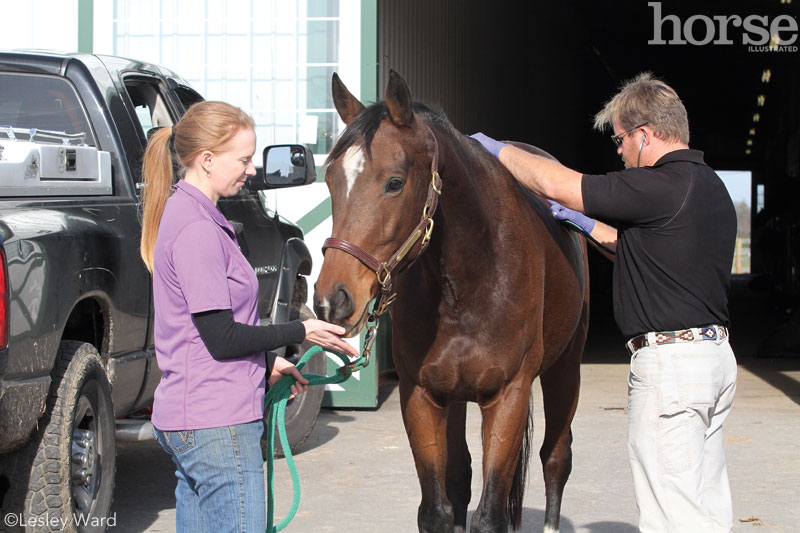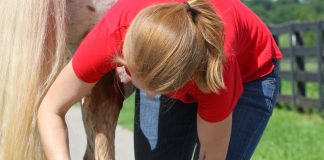
Spring and fall wellness exams are a great time for your vet to learn what’s normal for your horse.
A healthy horse is one in good body condition, with plenty of energy and a shining coat. This is a picture of a horse that is feeling good. Let’s look at some steps you can take to keep your horse the picture of health.
STEP 1: The Wellness Exam
Early detection of problems is particularly important for the senior horse, and he should be examined more often, in some cases three to four times per year. This schedule allows for early recognition and monitoring of Cushing’s disease, kidney or liver dysfunction, chronic lameness, and nutrition concerns. It also ensures proper attention to the increased dental care needs of the older horse.
In addition, a wellness exam provides the opportunity to establish a partnership with your vet, while also allowing your vet to become familiar with your horse. Once you’ve established a relationship with your vet, it’s easier to communicate concerns, such as a loss of appetite, sluggishness or a slight cough.
STEP 2: Immunizations
Before warmer weather brings an active riding season is the ideal time to have your veterinarian out for your horse’s annual spring checkup and health care visit. Appropriate immunizations will be given, including the core vaccines; these are important for every horse to have at least once a year regardless of geographic location or athletic use. These core vaccines include tetanus, Eastern and Western equine encephalomyelitis (EEE and WEE), West Nile virus (WNV), and rabies virus. Respiratory viral vaccines are important as well, especially if your horse attends events with comingling of horses from many places.
A horse should also receive other vaccines for diseases with a high risk in your area. Some vaccines require twice-yearly boosters; broodmares and foals have other special considerations. Collaborate with your veterinarian to tailor a strategy to your horse’s specific requirements based on risk of exposure.
STEP 3: Biosecurity
Vaccines are only one part of the artillery against disease. It’s also important for you to implement good horsekeeping and biosecurity strategies on your farm to further minimize risk. Consider what your horses do, where they travel, and how they might be exposed. Biosecurity measures help prevent disease outbreaks on your farm. Some worthwhile strategies include:
- Before admitting any horse to your farm, require a current negative Coggins test for equine infectious anemia. In addition, the horse should receive a veterinary health inspection and certificate within the immediate time period (72 hours) before entering your premises. If you are moving your horse, comply with these policies on behalf of all the horses stabled where your horse will be going.
- All incoming horses should be current on their immunizations, especially those for contagious diseases, and should be up to date on parasite control. Have additional diagnostic testing done prior to arrival, especially if the horse has an unknown medical history or a recent illness or exposure. For example, detection of a carrier for Streptococcus equi (strangles) is done via bacterial culture of a sample from nasopharyngeal swabs.
- Isolate all newcomers for two to three weeks at a sufficient distance from resident horses. Designate the isolation boundaries with clear signs and markings. Similarly, resident horses that travel to and from training and competition events should be housed in areas separate from non-traveling resident horses.
- Develop a plan that prevents contact between quarantined and healthy horses on the farm through physical separation and limiting who or what comes in contact with the isolated horses. This includes caretakers, veterinarians, farriers, trainers, suppliers, equipment and vehicles. All newcomers’ equipment, tools, bedding and feed containers should be kept separate from those of resident horses.
- Monitor horses in isolation and those returning after comingling with outside horses carefully and daily for any signs of disease. Take rectal temperatures twice daily; inspect for a cough, nasal discharge, loose feces, or a fever, and record all findings in a daily log.
- You should also use fly repellent or fly masks and sheets to repel biting insects, prevent irritation to the eyes, and minimize insect-borne diseases like pigeon fever, WNV, EEE and WEE.
STEP 4: Parasite Control
Another important step in your horse’s health management is control of internal parasites. The best approach relies on knowing which deworming medications are effective on your farm.
You’ll also need to determine how often to deworm each horse, as individuals vary. To do this, have your vet perform a fecal egg count reduction test (FECRT) once or twice a year. This will tell you how many eggs per gram (EPG) are present in the feces before and after deworming with a particular product. Checking each horse’s egg load identifies horses with low, moderate or high egg counts, and can be used to identify the most effective deworming drug class to use on that property.
Follow these additional strategies to help minimize your horse’s internal parasite load:
- Remove manure from paddocks at least twice weekly to eliminate parasite eggs before they develop into infective larvae.
- Keep a small number of horses per pasture so they can avoid grazing near patches of manure.
STEP 5: Stabling Care
Your horse’s living arrangements have a lot to do with his health. Maximize ventilation in your barn to improve the air quality he breathes. Ammonia fumes in a closed-up barn are particularly damaging to the respiratory tract.
Hay dust can also challenge the respiratory tract. When purchasing hay, shake out a flake or two to examine the amount of dust. Check that the hay has been dried well in the field and baled with minimal moisture, which can cause mold growth. Additionally, protect your hay and feed storage areas from excess moisture. Such attention to detail minimizes the risk of mold contamination that can cause allergic respiratory problems. Providing hay of excellent quality pays dividends in respiratory, intestinal and overall health.

Good ventilation is important in any barn, and will keep equine airways healthy.
Another critical element to keeping your horse healthy is access to clean water at all times. During the winter months, this also means access to ice-free water. A horse that stops drinking is more likely to suffer from impaction colic, or may decrease his feed consumption. In summer, count on your horse drinking 10 to 20 gallons per day; in winter, a horse generally consumes about 5 to 10 gallons of water per day, and more if exercised.
Tank heaters keep water ice-free and less frigid in winter climates. For stock tanks, heaters with elements that rest on the bottom of the trough are safest. Before the onset of winter, check that tank heaters work and are not passing electrical current into the water. Shield electrical cords in protective casing by running them through plastic piping or secure them out of reach of inquisitive mouths. In stalls, plug-in buckets with coil-wrapped cords are great if you have sufficient electrical outlets in your barn. Be sure to secure electrical wires out of the reach of horses.
Turnout is also very important to both physical and mental health. Social interaction with other members in a herd helps to minimize stable vices and other behavioral problems.
STEP 6: Minimize Stress
Horses may become stressed from transport, crowding, living with noncompatible horses, and also from nutritional deficits—these all play a role in increasing your horse’s susceptibility to disease.
Transport stress is a known cause of respiratory illness. While being hauled in a trailer with his head tied up for prolonged periods, your horse inhales debris and bacteria that can make its way into his lungs. Coupled with this is the adverse impact of general stress on your horse’s immune response. Develop strategies to make your horse’s trailer journey as calm and comfortable as possible, in addition to providing optimal ventilation and keeping the trailer environment clean.
STEP 7: Nutrition
Good nutrition is important for keeping your horse healthy through all four seasons. A forage-based diet is what your horse has evolved to eat, rather than loading up on grain and concentrates. Pasture, hay, pelleted complete feed and beet pulp are all high in fiber. Fat supplements (vegetable oil or rice bran) provide an excellent and safe means of feeding extra calories without the risk of the carbohydrate overload of grain. When evaluating your horse’s hay consumption, be sure to factor in the amount lost to wind and trampling, which renders it unpalatable.
For every degree below freezing, your horse’s nutritional needs could increase by as much as 5 to 10 percent. Good-quality grass hay is fermented by microbes in the large intestine to generate heat from within, like an internal combustion chamber.
In all cases, it’s useful to consult with your veterinarian about your horse’s body condition and diet so his feeding plan can be tweaked to account for any deficiencies or specific health concerns.
STEP 8: Routine Dental Care
Since horses’ teeth erupt continuously and grind up tough, stemmy food, the molars often develop sharp points along their edges, preventing them from meeting up properly to crush feed. To promote efficient digestion, have your horse’s teeth checked by your vet at least once a year so corrective work can be performed as needed. Feed that is properly ground by the teeth will ensure maximum absorption of nutrients.
Removing sharp points and hooks will also eliminate any pain in the horse’s mouth when he’s being ridden; dental problems are often the cause of head tossing and other evasive behaviors.
STEP 9: Farrier Care
To stay as sound as possible, your horse should have his hooves trimmed regularly. If he’s shod, his shoes should be reset or replaced at that time. Some horses need trimming every four to six weeks, while others can go eight to 10 weeks between farrier visits. The rate of hoof growth depends on the season, amount of exercise, and each horse’s individual tendencies. Feet that are allowed to grow too long can develop problems that create discomfort and pain. Trimming excessively in either length or frequency can also experience bruising and discomfort. The objective is to strike a fine balance that is tailored to each individual.
STEP 10: Education
Of all the steps to a healthier horse, one of the most effective ones is to educate yourself. Have conversations with your veterinarian and read reputable horse health resources. Attend continuing education programs sponsored by your vet, and ask questions of knowledgeable folks in the horse industry. That way, you’ll continually learn more about proper horse management so you can make improvements. It is attention to the tiniest details that helps your horse prosper.
NANCY S. LOVING, DVM, is a performance horse veterinarian based in Boulder, Colo., and is the author of All Horse Systems Go.
This article originally appeared in the March 2015 issue of Horse Illustrated magazine. Click here to subscribe!






Not being in a stall or barn most of the day, is also very important. Not just an hour out, while stall is being cleaned. Try to make your horse in a “natural” setting, where your horse would be in a herd and out eating most of the day.